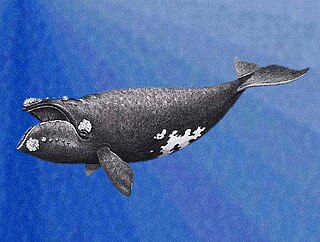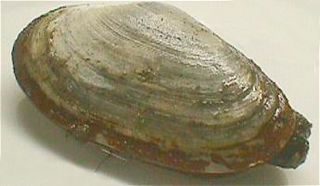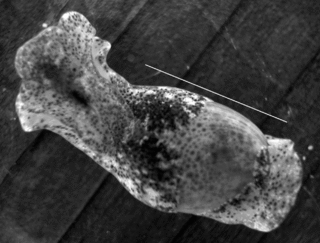
Honeysuckles are arching shrubs or twining vines in the genus Lonicera of the family Caprifoliaceae. It includes 158 species native to northern latitudes in North America, Eurasia, and North Africa. Widely known species include Lonicera periclymenum, Lonicera japonica and Lonicera sempervirens. L. japonica is a highly invasive species considered a significant pest in parts of North America, Europe, South America, Australia, and Africa.

Balaenidae is a family of whales of the parvorder Mysticeti that contains mostly fossil taxa and two living genera: the right whale, and the closely related bowhead whale.

The North Pacific right whale is a very large, thickset baleen whale species that is extremely rare and endangered. On average and maximum weight, they are the second largest whale species in the world.

Cryptomeria is a monotypic genus of conifer in the cypress family Cupressaceae. It includes only one species, Cryptomeria japonica. It used to be considered by some to be endemic to Japan, where it is known as Sugi. The tree is called Japanese cedar or Japanese redwood in English. It has been extensively introduced and cultivated for wood production on the Azores.

Lonicera japonica, known as Japanese honeysuckle and golden-and-silver honeysuckle, is a species of honeysuckle native to East Asia, including many parts of China. It is often grown as an ornamental plant, but has become an invasive species in a number of countries. Japanese honeysuckle is used in traditional Chinese medicine.

Kerria japonica, commonly known as Japanese kerria or Japanese rose, is a deciduous, yellow-flowering shrub in the rose family (Rosaceae), native to China, Japan and Korea. It is the only species in the genus Kerria. In the wild, it grows in thickets on mountain slopes. Japanese kerria has been used for medicine and is also planted in gardens. A double-flowered cultivar, K. japonica 'Pleniflora', is commonly called bachelor's buttons.

Mya is a genus of saltwater clams, marine bivalve molluscs in the family Myidae. They are widespread and abundant in northern waters. Commonly known as Ipswich clams, soft-shell clam or steamers, they are routinely used as a food source for humans.

Eels are ray-finned fish belonging to the order Anguilliformes, which consists of eight suborders, 20 families, 164 genera, and about 1000 species. Eels undergo considerable development from the early larval stage to the eventual adult stage and are usually predators.
Microglyphis globularis is a species of sea snail, a marine gastropod mollusk in the family Ringiculidae.
S. japonica may refer to:

Charybdis japonica, the Asian paddle crab, is a species of swimming crab in the family Portunidae. Charybdis japonica has a hexagonal, concave carapace around 12 centimetres (4.7 in) wide, the whole animal being pale green to olive green in colour.

Zebina is a genus of minute sea snails, marine gastropod mollusks or micromollusks in the family Zebinidae.

Hallyeohaesang National Park is a national park in Yeosu, South Korea. It was designated as national park in 1968. It has six districts: Sangju-Geumsan Mountain, Namhaedaegyo, Sacheon, Tongyeong-Hansan, Geoje-Haegeumgang, and Yeosu-Odongdo. The total area is 545.63 km2 (210.67 sq mi) with 395.49 km2 (152.70 sq mi) being marine area and 150.14 km2 (57.97 sq mi) being land area.

Haloa japonica, common name the Japanese bubble snail, is a species of sea snail or bubble snail, a marine opisthobranch gastropod mollusc in the family Haminoeidae, one of the families of bubble snails.

Polycera japonica is a species of sea slug, a nudibranch, a shell-less marine gastropod mollusc in the family Polyceridae.

Xenoturbella japonica is a marine benthic worm-like species that belongs to the genus Xenoturbella. It has been discovered in western Pacific Ocean by a group of Japanese scientists from the University of Tsukuba. The species was described in 2017 in a study published in the journal BMC Evolutionary Biology, and amended in 2018.

Cyphastrea is a genus of massive reef building stony corals in the family Merulinidae, commonly known as brain coral.

Microglyphis is a genus of gastropods belonging to the family Ringiculidae.

Microglyphis curtula is a species of sea snail, a marine gastropod mollusk in the family Ringiculidae.

Microglyphis perconica is a species of sea snail, a marine gastropod mollusk in the family Ringiculidae.


















